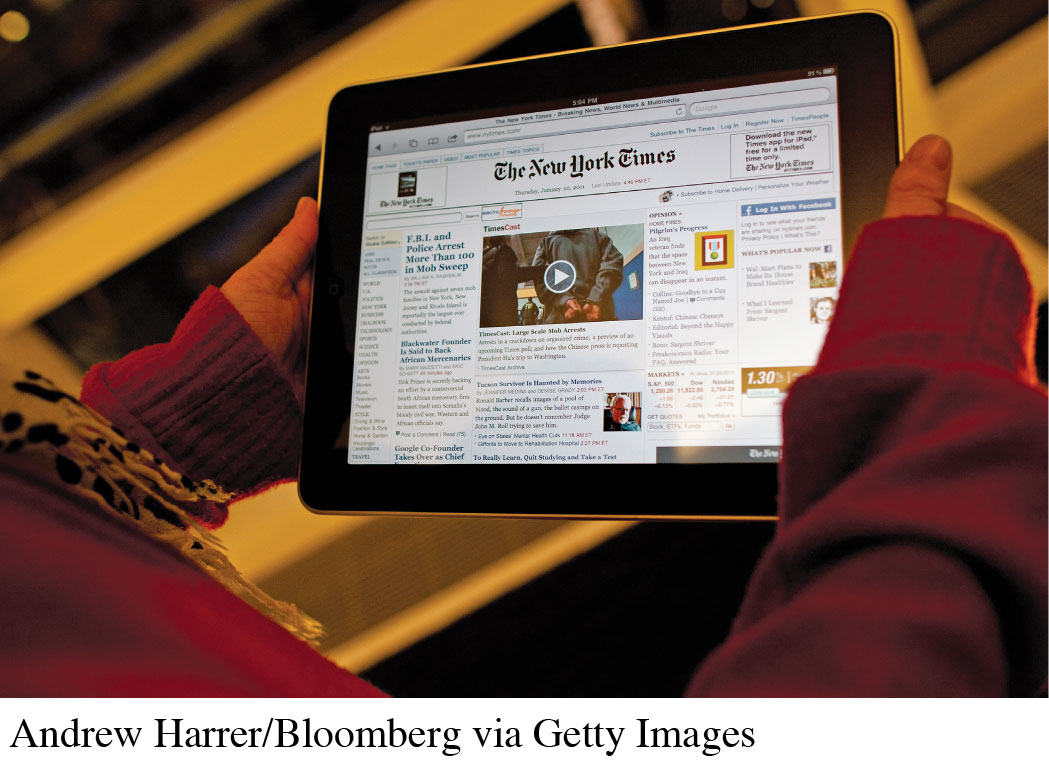The Evolution of Newspaper Journalism: Competing Models and the Rise of Professionalism
In the late 1800s, as newspapers pushed to expand circulation even further, two distinct types of journalism emerged: the story-driven model, which dramatized important events and characterized the penny papers and the yellow press; and “the facts” model, an approach that seemed more impartial and was favored by the six-cent papers.3 Provocative questions arose: Could news accounts be entirely objective? Should reporters actively interpret the meaning of particular events for readers? And later, as the profession and culture of journalism moved from print into broadcasting and online reporting, these new media, with their different sets of abilities and limitations, required different approaches to the news.
“Objectivity” and Professionalization in Modern Journalism
Throughout the mid-1800s, the more a newspaper appeared not to take sides on its front pages, the more readers it could attract. Also at this time, wire service organizations were serving a variety of newspaper clients in different regions of the country. To satisfy all their clients, newspapers strived for the appearance of impartiality—presenting “the facts” and leaving it up to readers to interpret the implications for their own lives. At the same time, the more sensational aspects of yellow journalism created an image problem for newspapers and their style of journalism, with journalists seen at best as low-status tradesmen and at worst as disreputable. But with the approach of the twentieth century, newspapers and journalism were about to start changing.
Adolph Ochs and the New York Times

The ideal of an impartial, or purely informational, news model was reinvented by Adolph Ochs, who bought the New York Times in 1896. Through wise hiring, Ochs and his editors rebuilt the paper around substantial news coverage and provocative editorial pages. To distance the Times from the yellow press, the editors also downplayed sensational stories, favoring the documentation of major events or issues and developing a powerful marketing message touting the Times as the higher-brow choice.
With the Hearst and Pulitzer papers capturing the bulk of working- and middle-class readers, managers at the Times initially tried to use their straightforward, “no frills” reporting to appeal to more affluent and educated readers. In 1898, Ochs also lowered the paper’s price to a penny. Soon middle-class readers gravitated to the paper as a status marker for the educated and well informed. Between 1898 and 1899, circulation soared from 25,000 to 75,000. By 1921, the Times had a daily circulation of 330,000 and a Sunday circulation of 500,000.
“Just the Facts, Please”: Journalism Gets Professional
Early in the twentieth century, with reporters adopting a more “scientific” attitude to news- and fact-gathering, the ideal of objectivity took a firmer hold in journalism. In objective journalism, which distinguishes factual reports from opinion columns, reporters strive to maintain a neutral attitude toward the issue or event they cover. They also search out competing points of view among the sources for a story in an effort to provide balanced coverage.
The early twentieth century was also a time when even the most notorious yellow journalists wanted to boost the respectability of the news business. That, combined with a broader cultural trend that favored a more “scientific” approach to the world, pushed the training of new journalists away from apprenticeships and toward universities. Early in the century, Joseph Pulitzer approached Columbia University in New York about setting up the first journalism school. He wanted to see the status of journalists rise to that of other professionals, such as lawyers and doctors. But the reputation of journalism was such that it took several years for the directors of the school to accept the millions Pulitzer offered, finally founding the school in 1912. (In addition to offering graduate degrees, the school began awarding the coveted Pulitzer Prizes in journalism in 1917 and continues to do so to this day.) But the distinction of being the first journalism school in the United States goes to a different Columbia: the School of Journalism at the University of Missouri in Columbia, Missouri, founded in 1908.4
Interpretive Journalism
By the 1920s, people began wondering whether the impartial approach to news reporting was sufficient for helping readers understand complex national and global developments. As one news scholar contended, it was partly as a result of “drab, factual, objective reporting” that “the American people were utterly amazed when [World War I] broke out in August 1914, as they had no understanding of the foreign scene to prepare them for it.”5 Such concerns triggered the rise of interpretive journalism, which aims to explain the ramifications of key issues or events and place them in a broader historical or social context.
Editor and columnist Walter Lippmann insisted that although objectivity should serve as journalism’s foundation, the press should do more. He ranked three press responsibilities: (1) “to make a current record”; (2) “to make a running analysis of it”; and (3) “on the basis of both, to suggest plans.”6
The rise of radio in the 1930s intensified tensions between the objective and interpretive models of print journalism. As radio gained in popularity, broadcasters increasingly took their news directly from papers and wire services. Seeking to maintain their dominion over “the facts,” some newspaper editors and lobbyists argued that radio should provide only interpretive commentary. Other print journalists argued that it was interpretive stories, not objective reports, which could best help newspapers compete against radio. However, most U.S. dailies continued relegating interpretive content to a few editorial and opinion pages.
It wasn’t until the 1950s—with the outbreak of the Korean War, the development of atomic power, the deepening of the Cold War, and the U.S. anticommunist movement—that newspapers began providing more interpretive journalism. They did so in part to compete with the latest news medium: television. And their interpretive material often took the form of an “op-ed” page—which appeared opposite the traditional editorial page. The op-ed page offered a wider variety of columns, news analyses, and letters to the editor.